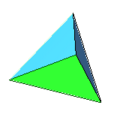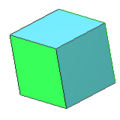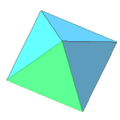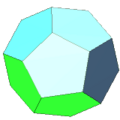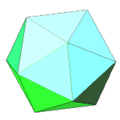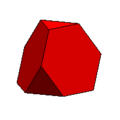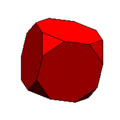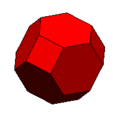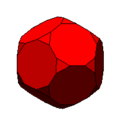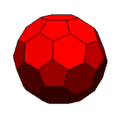Polyhedron
A polyhedron is a three-dimensional geometric closed figure bounded by a connected set of polygons. A polyhedron, in Euclidian geometry, must have at least four faces. A polyhedron of four sides is called a tetrahedron, six sides a hexahedron, eight sides an octahedron, ten sides a decahedron. Figures with more sides are typically named with the Greek name for the number of sides, followed by "-hedron".
The polygons bounding a polyhedron are known as faces; the line segments bounding the polygons are known as edges, and the points where the faces meet are vertices (singular vertex).
A convex polyhedron bounded by faces which are all the same-sized regular polygon is known as a Platonic solid. There are only five Platonic solids, shown below:
regular tetrahedron:4 triangle faces, 4 vertices, 6 edges
regular octahedron: 8 triangle faces, 6 vertices, 12 edges
regular dodecahedron: 12 pentagon faces, 20 vertices, 30 edges
regular icosahedron: 20 triangle faces, 12 vertices, 30 edges
A convex polyhedron bounded by faces of more than one type of regular polygon, with all edges the same length and all vertices identical is called an Archimedian solid. There are 13 Archimedian solids, shown below:
truncated tetrahedron:4 hexagon + 4 triangle faces, 12 vertices, 18 edges
truncated cube: 6 octagon + 8 triangle faces, 24 vertices, 36 edges
truncated octahedron: 8 hexagon + 6 square faces, 24 vertices, 36 edges
truncated dodecahedron: 12 decagon + 20 triangular faces, 60 vertices, 90 edges
truncated icosahedron: 20 hexagon + 12 pentagon faces, 60 vertices, 90 edges
